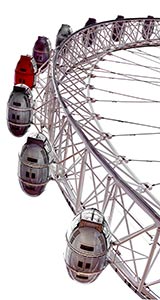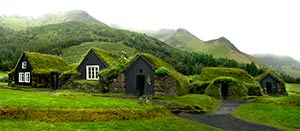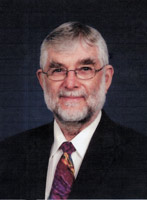
Gallery Partners
Artists-in-Residence
If you are unable to visit our gallery and would like to purchase photographs from this preview or others in the gallery, please contact the gallery and call 585-271-2540.
Peter Marr's Picks of the Show
Size Mattersby David Bleich
Peter
Marr has chosen his "Picks of the Show"
and presents a commentary on
their choices.
click here to return to the details of the exhibit
All images copyright by the individual photographers
London Eye It is a great tribute to David’s artistic and
visionary skills that he chose to photograph a segment of the London
Eye, using an imaginative viewpoint, that results in a memorable and
impressive image. This spectacular engineering construction, reminiscent
of a Ferris wheel, has offered visitors over 15 years of eye-catching,
360 degree views of the London metropolis. Here is a work of art that
the photographer has frozen in time, and observers are left to explore
it internally in their own time. One should caution that as memory is an
important part of vision, there can be no objective vision, because each
of us has a different memory. What one sees is a magical curved sweep of
a sector of the London Eye that beautifully highlights the glass
capsules mounted outside the rim, giving passengers an unobstructed
view, and an exhilarating
ride in space up to a height of over 450 feet above the ground. The
decision making parts the brain have an instinct to find and accept
symmetrical geometric forms and patterns, so the display of curved lines
will offer rewards and feelings of relaxation. These feelings would
become more tense when dealing with the distinctive lines of the cable
spokes, which ironically, are positioned to hold the structure in
tension. What separates this image from the thousands of other
photographs of the London Eye, is that David has used a “High Key”
effect, eliminating the sky and any other extraneous detail, to
highlight just the curved segment against a white background. Not only
does this allow the observer to take in the majesty of every detail of
this engineering marvel, most importantly, from the photographer’s
viewpoint, the total emphasis is what one sees, and not what the
passengers are viewing from each of the capsules. In conclusion, one
observation that could be distracting for some people, is that one of
the glass capsules has been painted underneath a blood-orange color. For
many people, this bright color immediately draws the eye away from the
silvery-gray pods which are its neighbors, resulting in a disruption to
the symmetry of this circular structure. Nevertheless, this is an
outstanding image, masterfully printed and displayed in a vertical
format that takes one to the top and beyond the London Eye itself.
Viking
Huts
This is one of the most sublime and meaningful
landscapes that I have ever seen, made all the more spectacular and
evocative, by the fact that the large panoramic display is mounted on an
acrylic substrate, which adds a resplendent brilliance and clarity to
the print. The verdant and lush green grasses continue their inspiring
presence all the way up the steep hillside, through the stands of
conifer trees, before merging with the almost barren hillsides of
volcanic peaks which are enshrouded in mist. In the foreground,
imposingly set against this impressive landscape, are a row of Viking
turf houses, so named, because each roof is covered with multiple layers
of living grass sod. Remarkably, the roof lines of the houses flow in an
undulating pattern that mirrors closely the background setting The
massive stone walls help support and insulate these houses, and in front
is a stone and gravel pathway which connects all of these dwellings. The
Icelandic turf house is an exceptional example of Vernacular
architectural tradition, which was brought to the country by Nordic
settlers dating back to the 9th century. They are
predominantly of timber and stone construction, around and over which,
thick layers of turf form an insulating cover. It is remarkable that in
one of the world’s most inhospitable lands of volcanoes, earthquakes,
and glaciers, the Icelanders have learned to survive at the edge of the
Arctic, living in turf house communities until the early 1900’s. Many of
these structures are in the National Museum’s Historic collection, and
many have been remodeled and reconstructed for rental and hostel use for
tourists. I have given some of this background data in order that
viewers of this exceptional landscape be more aware of a sense of
presence, and to imagine that they have the freedom to stop and enter
any one of the dwellings. There, in a visionary way, the observer can
conjecture and think about the people, their way of life, their
hardships, etc, so that this historic and august print means even more
to them.
Peter's Picks

by David Bleich

by David Bleich

Image City Photography Gallery ♦ 722 University Avenue ♦ Rochester, NY 14607 ♦ 585.271.2540
In the heart of ARTWalk in the Neighborhood of the Arts